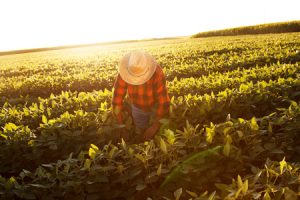[breadcrumb]
 How Can a Farmhand Get Mesothelioma by Occupational Exposure to Asbestos?
How Can a Farmhand Get Mesothelioma by Occupational Exposure to Asbestos?
Farmhands and other agricultural workers can be exposed to asbestos through many avenues. Many farmhands operated, maintained or repaired farm machinery, such as tractors, fertilizer spreaders, balers and combines. Some of these machines may have contained asbestos in their friction parts, including brakes, brake pads, brake linings and clutches. These components often had to be repaired and replaced often since they were standard instead of automatic. As these materials became worn, asbestos fibers would become dislodged from them and enter the air where farmhands, mechanics and others would breath them in.
Another potential source of exposure to asbestos was in vermiculite, which was often used in potting soils and other agricultural products. Vermiculite sometimes grew alongside asbestos. Sometimes it was contaminated with asbestos. The most common source of asbestos-contaminated vermiculite was from a vermiculite mine in Libby, Montana, which produced 80% of the world’s supply of vermiculite during its years of operation. A study in 1963 found vermiculite from the mine contained between 6.2% to 22.5% tremolite asbestos.
Asbestos also occurs naturally in soil. However, when farm work is completed on this soil, asbestos fibers are disturbed and released into the air where farmhands can breathe them in.
Additionally, asbestos was also included in buildings where farmhands regularly spent time, including farmhouses, barns, pens, sheds and silo. These buildings were constructed with materials that contained asbestos, including floor tiles, ceiling tiles, insulation, drywall, mortar and joint compound. Farmhands may have been asked to help construct or repair these structures as part of their job duties where they could have been exposed to asbestos. Additionally, as these structures deteriorated over time, these materials may have crumbled or cracked, resulting in the release of these fibers into the air where farmhands could inhale them.
Typical job duties of farmhands and other agricultural workers include:
- Harvest and inspect crops
- Irrigate farm soil
- Maintain ditches, pipes and pumps
- Operate farm machinery to plow and sow seeds
- Repair farm equipment
- Spray fertilizer or pesticide on or near crops
- Feed animals and clean their pens and cages
- Herd livestock to pastures
Locations in the United States for the Highest Employment Rates for Farmhands
According to the U.S. Bureau of Labor Statistics, there are currently 876,300 people employed in the category of “agricultural workers.” The classification of farmworkers and laborers, crop, nursery and greenhouse includes 287,420 workers. States with the highest employment rates for these workers include:
- California
- Washington
- Florida
- Arizona
- Oregon
Similar Occupations as Farmhands
Similar occupations as farmhands include:
- Agricultural and food science technicians
- Animal care and service workers
- Farmers, ranchers and other agricultural managers
- Forest and conservation workers
- Grounds maintenance workers
- Veterinary assistants and laboratory animal caretakers
Lawsuits and Settlements Involving Farmhands and Mesothelioma
There have been some notable cases involving farm workers and mesothelioma. For example, a jury awarded $38 million to a farm worker in 2013 after he was diagnosed with mesothelioma the jury attributed to exposure to asbestos products and that their manufacturers knew or should have known about the dangers of these products and failed to warn the worker. There have also been lawsuits filed against farm equipment manufacturers when farmers and others have developed mesothelioma and other asbestos-related diseases after they repaired heavy machinery on farms.
Studies Related to Farmhands and Asbestos
There have been several studies conducted regarding the link between agricultural workers and asbestos. Some of these studies include:
- “Pesticides and Lung Cancer Risk in the Agricultural Health Study Cohort” is a 2004 study published in the American Journal of Epidemiology. It found that asbestos was significantly associated with lung cancer within the study.
- “Asbestos and agriculture: new perspectives of risk” is a 2012 study that shows the risk of exposure to tremolite asbestos in agriculture is significantly higher than natural exposure. The study showed that agricultural activities increased exposure to asbestos fibers that occurred naturally of two fibers per liter to 23.6 fibers per liter.
- A 1998 study regarding respiratory health hazards in agriculture stated that researchers were investigating high numbers of asbestosis in agricultural workers as early as 1967.
- A 2005 study showed a direct link between naturally occurring asbestos and an increased rate of mesothelioma in nearby farmers. It found that the closer a farm is to naturally occurring asbestos, the greater the chance of being diagnosed with mesothelioma.
Types of Asbestos Products Used by Farmhands
Farmhands may have worked with asbestos-containing products, such as:
- Agricultural filler
- Pesticides
- Animal feed
- Potting mix
- Root cuttings
- Seed germination
- Seed encapsulation
- Gaskets
- Valves
- Brakes
- Brake pads
- Seals
- Clutches
- Engine parts and other mechanical components
- Asbestos cement
- Roofing
- Siding
- Piping
- Insulation
- Floor tiles
- Paint
Manufacturers of Asbestos Products Used by Farmhands
Some manufacturers of products used by farmhands that have been named in asbestos litigation include:
- Byron Jackson
- Caterpillar
- Crane Co.
- Durco
- John Deere Co.
